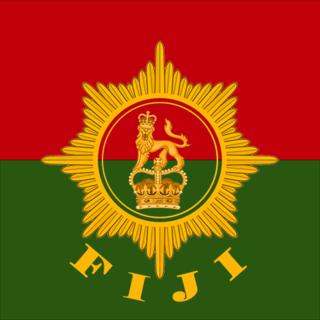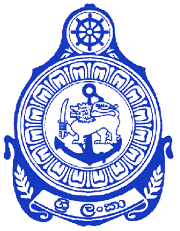
The Republic of Fiji Military Forces is the military force of the Pacific island nation of Fiji. With a total manpower of about 6,500 active soldiers and approximately 6,200 reservists, it is one of the smallest militaries in the world and the third largest in the South Pacific region. The Ground Force is organised into six infantry and one engineer battalions.

The Falkland Islands are a British overseas territory and, as such, rely on the United Kingdom for the guarantee of their security. The other UK territories in the South Atlantic, South Georgia and the South Sandwich Islands, fall under the protection of British Forces South Atlantic Islands (BFSAI), formerly known as British Forces Falkland Islands (BFFI), which includes commitments from the British Army, Royal Air Force and Royal Navy. They are headed by the Commander, British Forces South Atlantic Islands (CBFSAI), a brigadier-equivalent appointment that rotates among all three services.

The Royal Navy (RN) is the naval warfare force of the United Kingdom, British Overseas Territories and Crown Dependencies, and a component of His Majesty's Naval Service. Although warships were used by English and Scottish kings from the early medieval period, the first major maritime engagements were fought in the Hundred Years' War against France. The modern Royal Navy traces its origins to the English Navy of the early 16th century; the oldest of the UK's armed services, it is consequently known as the Senior Service.

The Royal Australian Navy (RAN) is the naval branch of the Australian Defence Force (ADF). The professional head of the RAN is Chief of Navy (CN) Vice Admiral Mark Hammond. The Chief of Navy is also jointly responsible to the Minister for Defence (MINDEF) and the Chief of the Defence Force (CDF). The Department of Defence, which is a part of the Australian Public Service, administers the ADF, and ergo, the Royal Australian Navy. In 2023, the Surface Fleet Review was introduced to outline the future of the Navy.

A coast guard or coastguard is a maritime security organization of a particular country. The term embraces wide range of responsibilities in different countries, from being a heavily armed military force with customs and security duties to being a volunteer organization tasked with search and rescue without law enforcement authority. In most countries, a typical coast guard's functions are distinct from those of the navy and the transit police, while in certain countries they have similarities to both.

The South African Navy (SA Navy) is the naval warfare branch of the South African National Defence Force.

Standing Royal Navy deployments is a list of operations and commitments undertaken by the United Kingdom's Royal Navy on a worldwide basis. The following list details these commitments and deployments sorted by region and in alphabetical order. Routine deployments made by the Navy's nuclear-powered submarines and their location of operations is classified.

HMS Enterprise, the tenth ship to bear this name, was a multi-role survey vessel - hydrographic oceanographic (SVHO) of the Royal Navy along with HMS Echo that made up the Echo class of survey vessels.

HMS Mersey is a River-class offshore patrol vessel of the British Royal Navy. Named after the River Mersey, she is the fifth RN vessel to carry the name and the first to be named Mersey in 84 years. Various tenders were renamed Mersey during their service with Mersey Division Royal Naval Reserve between the early 1950s and late 1970s.

The Naval Service is the maritime component of the Defence Forces of Ireland and is one of the three branches of the Irish Defence Forces. Its base is in Haulbowline, County Cork.

His Majesty's Naval Service is the United Kingdom's naval warfare and maritime service. It consists of the Royal Navy, Royal Marines, Royal Fleet Auxiliary, Royal Naval Reserve, Royal Marines Reserve and Naval Careers Service. The Naval Service as a whole falls under the command of the Navy Board, which is headed by the First Sea Lord. This position is currently held by Admiral Sir Ben Key. The Defence Council delegates administration of the Naval Service to the Admiralty Board, chaired by the Secretary of State for Defence.

The Gibraltar Squadron is a unit of the British Royal Navy. It is the only seagoing Royal Naval unit based in Gibraltar, attached to British Forces Gibraltar. It currently includes two Cutlass-class fast patrol boats with a maximum speed of up to 41-knots. The squadron also uses three Pacific 24 rigid-hulled inflatable boats and deploys one diving support boat. The 2021 defence white paper indicated that henceforth, one River-class offshore patrol vessel, HMS Trent, would also be permanently based in Gibraltar for operations in the Mediterranean and in the Gulf of Guinea. As of 2023, 28 personnel were assigned to the squadron, along with additional personnel assigned to HMS Trent.

The Sri Lanka Navy (SLN) is the naval arm of the Sri Lanka Armed Forces and is classed as the country's most vital defence force due to its island geography. It is responsible for the maritime defence of the Sri Lankan nation and its interests. The role of the Sri Lanka Navy is to conduct operations at sea for the defence of the nation and its interests and conduct prompt and sustainable combat operations at sea in accordance with the national policies.

British Forces Gibraltar constitute those elements of the British Armed Forces stationed in the British overseas territory of Gibraltar. Gibraltar is used primarily as a training area, thanks to its good climate and rocky terrain, and as a stopover for aircraft and ships en route to and from deployments East of Suez or in Africa.

Border Force (BF) is a British law enforcement command within the Home Office, responsible for frontline border control operations at air, sea and rail ports in the United Kingdom. The force was part of the now defunct UK Border Agency from its establishment in 2008 until Home Secretary Theresa May demerged it in March 2012 after severe criticism of the senior management.
Operation Mare Nostrum was a year-long naval and air operation commenced by the Italian government on 18 October 2013, which rescued at least 150,000 migrants on the dangerous Mediterranean sea crossing. The operation ended on 31 October 2014, and was superseded by Frontex's Operation Triton.
An increasing number of refugees and migrants have been entering the United Kingdom illegally by crossing the English Channel in the last decades. The Strait of Dover section between Dover in England and Calais in France represents the shortest sea crossing, and is a long-established shipping route. The shortest distance across the strait, at approximately 20 miles, is from the South Foreland, northeast of Dover in the English county of Kent, to Cap Gris Nez, a cape near to Calais in the French département of Pas-de-Calais.

Operation Broadshare is the code name for the British military operation to address the COVID-19 pandemic overseas, primarily in the British Overseas Territories (BOTs) and British overseas military bases. The operation runs in parallel to a similar military operation in the United Kingdom, named Operation Rescript.
On 24 November 2021, an inflatable dinghy carrying migrants from France to the United Kingdom capsized in the English Channel causing the deaths of 27 of the 30 people on board. It is believed to be the deadliest incident in the English Channel since the International Organization for Migration began collecting data in 2014.















